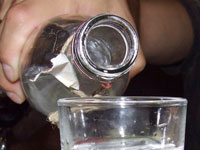Vodka Appeared as Flavored Drink in Ancient Russia
Only a few people know that the first strong, bitter and intoxicating liquid was made in the 11th century by a Persian doctor Ar-Razi. He was the first one to distill ethanol from grain mash, but could only use it for medical purposes since Koran prohibited alcohol consumption.

Until the mid 15th century, Russians didn’t know how to extract spirit by distillation. However, as early as at the end of the 9th century they learned to make strong alcoholic beverages from fermented berries and honey.
It would seem logical to assume that the lack of knowledge about distillation caused the production of low-quality, impure product. However, it was completely the opposite.
Since old times, Russian mead-brewers used mechanical methods to purify fermented honey. These methods were very similar to those used for purification of grape wines. Maturation and unique freezing of honey allowed removing fusel oils and other impurities together with the ice from the honey surface. This method made the recipe for producing hard liquor in Russia unique.
According to chronicles, vodka appeared in Russia at the end of the 14th century. In 1386, Genoese merchants brought to Moscow "aqua vitae" (live water) that was presented to Prince Dmitry Donskoy. Later, in 1503-1505, the monks of Chudovo monastery located on the territory of the Moscow Kremlin created the first recipe of original Russian vodka.
While other countries were perfecting distillation methods to achieve purity of alcohol, Russian brewers applied old methods of purification to the new semi-product received by means of distillation.
There were also original ways of alcohol purification where milk and egg whites were used as adsorbing agents. Vodka was filtered through birch coals, silver, felt, and even river sand.
The beverage became very popular, and in 1533 Russia introduced a state monopoly for vodka production and its sales in “tsar’s taverns.”
By the mid 18th century, the quality of Russian vodka reached its peak. It was produced exclusively in the households of land owners, where multiple types of vodka were invented. Variety, rather than standardization was the main focus in production.
Every land owner was striving to invent his own brand of vodka. At those times only flavored beverages were called “vodka.” Only natural fragrances derived from herbs, berries, fruit and seeds were used for vodka flavoring.
Many hospitable land owners considered it mandatory to have a complete collection of different vodkas so they could treat their guests to a drink named for any letter of the alphabet.
Today the list would look something like this: Absolute, Belvedere , Cirrus, Dubra, Effen , Finlandia, Grey Goose, Hangar One, IDÔL, Ketel One, Luksusowa, Orange V, Popov, Russian Standard, SKYY, Three Olives, Ultimat, Van Gogh, White Diamond, Zubrowka.
Sometimes land owners entertained their guests with vodka games: a guest would think of a word and pour into a glass several drops of different vodkas whose names began with the letters of this word. The owner had to guess the word by the flavors.
This speaks not only to the resourcefulness of the Russian cocktail-makers, but also to their high culture of drinking. The most important thing was to preserve sober reasoning, clear mind, and high ability to distinguish various fragrances of home-made vodka.
At the end of the 18th century, the fame of high-quality Russian vodka was spread throughout the entire Western Europe. Vodka made its way out of Russia, but in the form of gifts only. Even Katherine II was proud to give vodka as a gift to Frederick the Great or send it to Gustav III, King of Sweden.
In the 1860-1870 private production of vodka in Russia became very popular. It was very difficult for the government to control the quality of vodka and fresh raw material.
Soon Russia introduced the state monopoly for vodka production. Chemists got involved in the development of the production process to enable product standardization. “Moskovskaya Osobaya” brand is directly connected to the name of Dmitry Mendeleev, the inventor of the periodic table of elements.
It took the scientist 18 months to find a perfect ratio for volume of spirit to water. Mendeleev published his findings in his Doctoral thesis “Essay on integration of spirit with water. ” This is why Russian vodka is always 40% Alc. by Vol.
Mendeleev’s conclusions were appreciated and utilized in alcohol testing and vodka production. His work became the basis for the state comparison standard for the original Russian vodka established in 1894–1896. Today the quality of Russian vodka is unparalleled, and it remains one of the world’s famous alcoholic beverages.
Maksim Kondratyev
Pravda.Ru
Subscribe to Pravda.Ru Telegram channel, Facebook, RSS!


